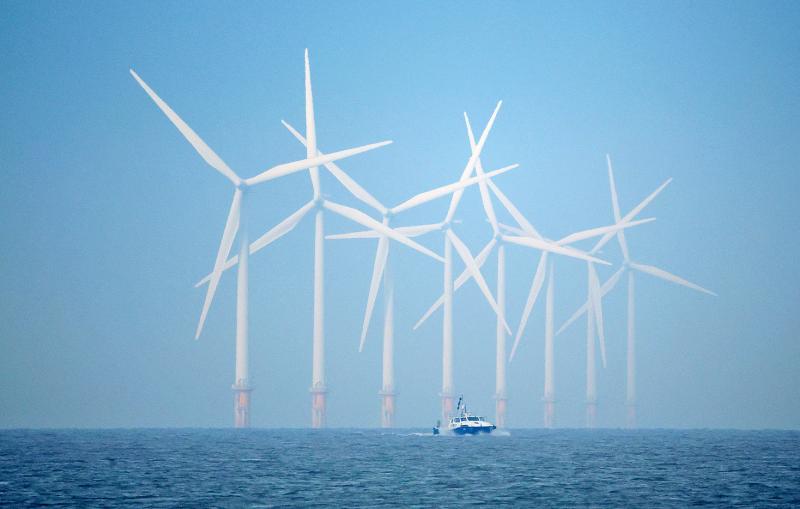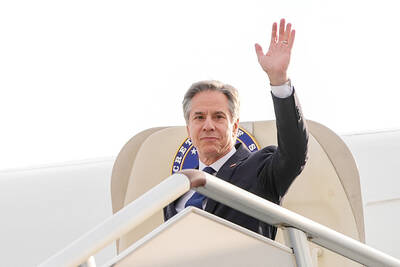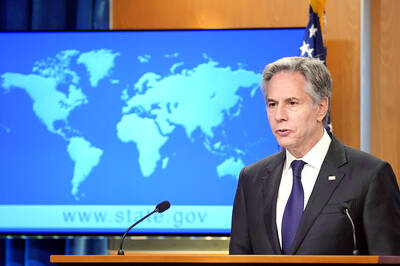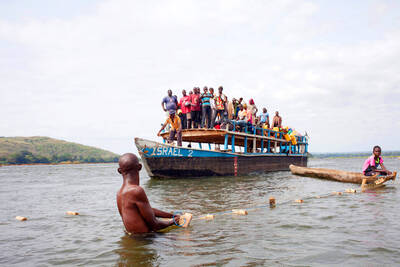Asian nations counting on offshore wind farms to meet clean energy goals are facing an increasing shortage of ships for installing the massive turbines in the sea.
As countries embark on a rapid buildout of wind power in the next decade, builders cannot churn out the support vessels fast enough to keep up, shipping experts have said.
The situation is only going to get worse as blades get longer and require bigger ships to handle them.

Photo: Reuters
“Specialized vessels are going to be in demand for projects in Taiwan and South Korea,” said Sean Lee, chief executive officer of shipyard Marco Polo Marine Ltd. “There will be more and more projects coming up, and a big wave of them in Japan from 2028.”
The complicated job of planting a wind turbine in the seabed requires several types of ships specially designed for the work: Turbine installers feature massive cranes capable of hoisting objects weighing as much as 700 tonnes. Commissioning service operation vessels, or CSOVs, provide adjustable gangways that allow technicians to reach the turbine blades.
Excluding China, there are only about 10 turbine installing ships and a few dozen CSOVs operating worldwide, according to shipbroker Clarksons.
By 2030, demand for turbine installers would outpace supply by about 15 vessels, while the gap for CSOVs would widen to more than 145 CSOVs from 30, it estimates.
China has 84 ships capable of installing wind turbines, according to trade group Global Wind Energy Council (GWEC).
However, the majority of those can only handle small turbines, with many having been converted from oil and gas ships. These are unlikely to meet specifications in Europe or elsewhere in Asia.
The shortage of ships is significant for Asia as the GWEC predicts the continent will top Europe as the region with the most new offshore wind installations through 2026.
A lack of vessels could set back countries’ efforts to diversify away from fossil fuels.
“The potential crunch is likely to occur in the mid-to-late 2020s as more countries begin constructing their wind farms to meet 2030 national targets,” said Bahzad Ayoub, a senior analyst at consultant Westwood Global Energy Group.
Many of the ships have been deployed to Europe, Lee said.
To fill the gap in Asia, tugs and support vessels that were serving oil rigs in Southeast Asia have been diverted to wind farms, he said.
However, using oil and gas ships cannot be a long-term solution and the current fleet of installation vessels might soon become obsolete as turbine sizes grow to be almost as long as the Eiffel Tower.
As technology advances, wind farms could see these lengths increase to 275m by 2030, the GWEC has said.
Larger turbines mean the required lifting heights and crane capacities of vessels installing the blades must increase, Ayoub said.
Shipping companies are racing to fill the gap. Marco Polo is building a CSOV by next year to be chartered by Vestas Wind Systems A/S in Taiwan. Cadeler A/S has ordered four turbine installation vessels for next year to 2026 from Cosco Heavy Industries, while Maersk Supply Service has ordered one from Sembcorp Marine Ltd for delivery to the US in 2025.

‘IN A DIFFERENT PLACE’: The envoy first visited Shanghai, where he attended a Chinese basketball playoff match, and is to meet top officials in Beijing tomorrow US Secretary of State Antony Blinken yesterday arrived in China on his second visit in a year as the US ramps up pressure on its rival over its support for Russia while also seeking to manage tensions with Beijing. The US diplomat tomorrow is to meet China’s top brass in Beijing, where he is also expected to plead for restraint as Taiwan inaugurates president-elect William Lai (賴清德), and to raise US concerns on Chinese trade practices. However, Blinken is also seeking to stabilize ties, with tensions between the world’s two largest economies easing since his previous visit in June last year. At the

UNSETTLING IMAGES: The scene took place in front of TV crews covering the Trump trial, with a CNN anchor calling it an ‘emotional and unbelievably disturbing moment’ A man who doused himself in an accelerant and set himself on fire outside the courthouse where former US president Donald Trump is on trial has died, police said yesterday. The New York City Police Department (NYPD) said the man was declared dead by staff at an area hospital. The man was in Collect Pond Park at about 1:30pm on Friday when he took out pamphlets espousing conspiracy theories, tossed them around, then doused himself in an accelerant and set himself on fire, officials and witnesses said. A large number of police officers were nearby when it happened. Some officers and bystanders rushed

Beijing is continuing to commit genocide and crimes against humanity against Uyghurs and other Muslim minorities in its western Xinjiang province, U.S. Secretary of State Antony Blinken said in a report published on Monday, ahead of his planned visit to China this week. The State Department’s annual human rights report, which documents abuses recorded all over the world during the previous calendar year, repeated language from previous years on the treatment of Muslims in Xinjiang, but the publication raises the issue ahead of delicate talks, including on the war in Ukraine and global trade, between the top U.S. diplomat and Chinese

RIVER TRAGEDY: Local fishers and residents helped rescue people after the vessel capsized, while motorbike taxis evacuated some of the injured At least 58 people going to a funeral died after their overloaded river boat capsized in the Central African Republic’s (CAR) capital, Bangui, the head of civil protection said on Saturday. “We were able to extract 58 lifeless bodies,” Thomas Djimasse told Radio Guira. “We don’t know the total number of people who are underwater. According to witnesses and videos on social media, the wooden boat was carrying more than 300 people — some standing and others perched on wooden structures — when it sank on the Mpoko River on Friday. The vessel was heading to the funeral of a village chief in